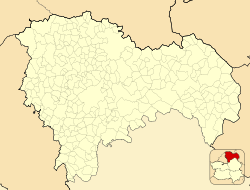Mazarete, Spain | |
|---|---|
 | |
| Coordinates: 41°00′08″N2°09′28″W / 41.00222°N 2.15778°W | |
| Country | |
| Autonomous community | |
| Province | Guadalajara |
| Municipality | Mazarete |
| Area | |
• Total | 55 km2 (21 sq mi) |
| Population (2024-01-01) [1] | |
• Total | 27 |
| • Density | 0.49/km2 (1.3/sq mi) |
| Time zone | UTC+1 (CET) |
| • Summer (DST) | UTC+2 (CEST) |
Mazarete is a municipality located in the province of Guadalajara, Castile-La Mancha, Spain. According to the 2004 census (INE), the municipality has a population of 66 inhabitants.


